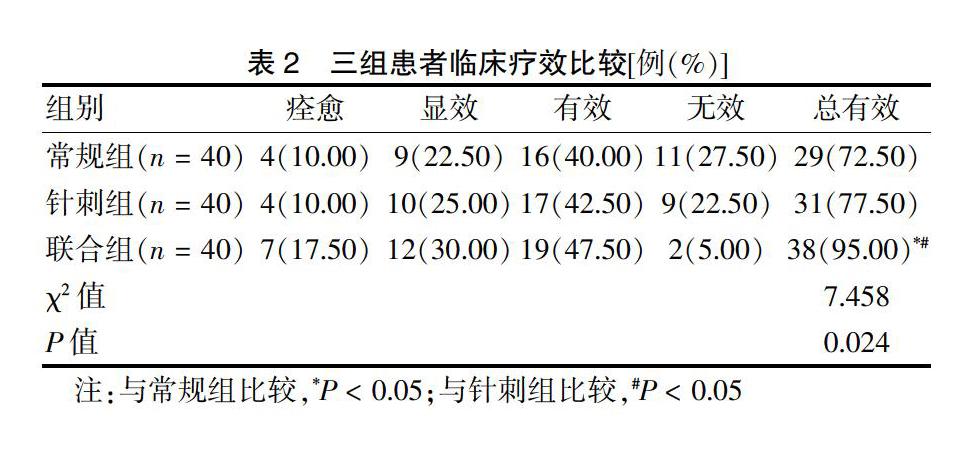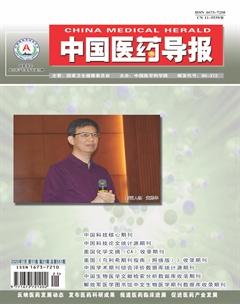血栓通脉汤联合针刺治疗脑卒中的临床研究
齐春蕾 田丙生



[摘要] 目的 探討血栓通脉汤联合针刺治疗脑卒中的临床效果。 方法 选择2017年1月—2019年1月山东省医学科学院附属医院收治的脑卒中患者120例,依照随机数字表法将其分为常规组、针刺组及联合组,各40例。常规组采用西药常规疗法,针刺组在常规组的基础上给予针刺治疗,联合组在针刺组的基础上给予血栓通脉汤治疗,三组均连续治疗3个月。治疗后进行临床疗效评价。比较三组治疗前后的中医症状评分、美国国立卫生研究院卒中量表(NIHSS)、格拉斯哥昏迷量表(GCS)评分及血清一氧化氮(NO)、内皮素(ET-1)水平。记录并比较三组治疗过程中不良反应发生情况。 结果 联合组的临床总有效率高于常规组和针刺组,差异有统计学意义(P < 0.05)。三组治疗后中医症状各项评分(肢体麻木、自汗、气短乏力、舌质暗)均低于治疗前(P < 0.05);针刺组和联合组治疗后中医症状各项评分均低于常规组(P < 0.05);联合组治疗后中医症状各项评分低于针刺组(P < 0.05)。三组治疗后NIHSS评分均低于治疗前,GCS评分均高于治疗前(P < 0.05);针刺组和联合组治疗后NIHSS评分均低于常规组,GCS评分均高于常规组(P < 0.05);联合组治疗后NIHSS评分低于针刺组,GCS评分高于针刺组(P < 0.05)。三组治疗后血清NO水平均高于治疗前,血清ET-1水平均低于治疗前(P < 0.05);针刺组和联合组治疗后血清NO水平均高于常规组,血清ET-1水平均低于常规组(P < 0.05);联合组治疗后血清NO水平高于针刺组,血清ET-1水平低于针刺组(P < 0.05)。三组治疗期间均无严重的不良反应发生。 结论 血栓通脉汤联合针刺治疗脑卒中临床效果显著,能够明显改善患者的神经功能和血管内皮功能损伤,且安全性较好。
[关键词] 脑卒中;血栓通脉汤;针刺;疗效;安全性
[中图分类号] R255.2 [文献标识码] A [文章编号] 1673-7210(2020)07(c)-0157-05
Clinical research of Xueshuan Tongmai Decoction combined with acupuncture in the treatment of cerebral apoplexy
QI Chunlei TIAN Bingsheng▲
Department of Rehabilitation Medicine, Affiliated Hospital of Shandong Academy of Medical Sciences, Shandong Province, Ji′nan 250031, China
[Abstract] Objective To explore clinical efficacy of Xueshuan Tongmai Decoction combined with acupuncture in the treatment of cerebral apoplexy. Methods One hundred and twenty patients with cerebral apoplexy admitted to Affiliated Hospital of Shandong Academy of Medical Sciences from January 2017 to January 2019 were selected. According to the random number table method, the patients were divided into routine group, acupuncture group and combined group, with 40 cases in each group. Routine group was treated with routine Western medicine. Acupuncture group was treated with acupuncture on the basis of routine group. Combined group was treated with Xueshuan Tongmai Decoction on the basis of acupuncture group. All three groups were treated for 3 months. Clinical efficacy was evaluated after treatment. The score of Chinese medicine symptoms, National Institute of Health stroke scale (NIHSS), Glasgow coma scale (GCS), serum nitric oxide (NO) and endothelin (ET-1) levels were compared before and after treatment. The incidence of adverse reactions during the treatment was recorded and compared among three groups. Results Total clinical effective rate of combined group was higher than that of routine group and acupuncture group (P < 0.05). After treatment, the scores of Chinese medicine symptoms (numbness of limb, spontaneous sweating, panting and weakness, dark tongue quality) in three groups were lower than those before treatment (P < 0.05); after treatment, the scores of Chinese medicine symptoms in acupuncture group and combination group were lower than those in routine group (P < 0.05); after treatment, the scores of Chinese medicine symptoms in combination group were lower than those in acupuncture group (P < 0.05). NIHSS scores of three groups after treatment were lower than those before treatment, GCS scores of three groups after treatment were higher than those before treatment (P < 0.05); NIHSS scores of acupuncture group and combination group after treatment were lower than those of routine group, GCS scores of acupuncture group and combination group after treatment were higher than those of routine group (P < 0.05); NIHSS score of combined group after treatment was lower than that of acupuncture group, GCS score of combined group after treatment was higher than that of acupuncture group (P < 0.05). After treatment, serum NO levels in three groups were higher than those before treatment, and serum ET-1 levels in three groups were lower than those before treatment (P < 0.05); serum NO levels in acupuncture group and combination group after treatment were higher than those in routine group, and serum ET-1 levels in acupuncture group and combination group after treatment were lower than those in routine group (P < 0.05); after treatment, serum NO level in combined group was higher than that in acupuncture group, and serum ET-1 level in combined group was lower than that in acupuncture group (P < 0.05). There were no serious adverse reactions during the treatment of three groups. Conclusion Xueshuan Tongmai Decoction combined with acupuncture has a significant clinical effect in treating cerebral apoplexy, which can significantly improve neurological function and vascular endothelial function damage of patients, and it has good safety.
[Key words] Cerebral apoplexy; Xueshuan Tongmai Decoction; Acupuncture; Efficacy; Safety
脑卒中是由于脑动脉血管粥样硬化的斑块破裂和脱落后在局部形成血栓以致脑血管被阻塞,造成该区域脑组织发生缺血缺氧性损伤,具有发病率高、致残致死率高的特点,对人们的身体健康造成极大的威胁[1]。目前,西医治疗脑卒中主要采用调控血糖、血脂、血压,清除自由基,抗血小板聚集等措施,然而对于部分患者的疗效并不理想[2]。中医认为,脑卒中是由于气血阴阳失调导致瘀阻脑络,故治疗应以益气养血、活血化瘀为宜[3]。针刺在治疗脑卒中后遗症方面的效果得到临床医师的认可,选穴水沟、百会、合谷等,具有通窍醒神、通经活络的作用[4]。血栓通脉汤是一种由黄芪、赤芍、党参、当归、桃仁、川芎、地龙、茯苓、红花、白术、全虫、甘草煎制而成的汤剂,具有通络祛瘀、调畅气血的作用[5]。本研究探讨血栓通脉汤联合针刺治疗脑卒中的效果及对内皮功能的影响,结果如下:
1 资料与方法
1.1 一般资料
选择2017年1月—2019年1月山东省医学科学院附属医院(以下简称“我院”)收治的120例脑卒中患者。纳入标准:①西医诊断标准参考《内科学》[6];②中医诊断标准参考《中医内科常见病诊疗指南》[7],辨证分型为气虚血瘀证;③患者生命体征稳定,能够进行合作;④知情同意。排除标准:①不能耐受针刺治疗;②合并严重心血管、肝脏及血液系统疾病;③精神异常、老年性痴呆;④妊娠或哺乳期妇女;⑤对本研究所用药物过敏。所有患者采用随机数字表法分为常规组、针刺组及联合组,各40例。三组一般资料比较差异无统计学意义(P > 0.05),具有可比性。见表1。本研究经我院医学伦理委员会批准。
1.2 治疗方法
常规组给予常规治疗:阿司匹林(拜耳医药保健有限公司,规格:100 mg/片,生产批号:20161105)口服,200 mg/d,1次/d;维生素E(青岛双鲸药业股份有限公司,规格:0.1 g/颗,生产批号:20161018)口服,0.1 g/d,1次/d;合并有糖尿病、高血压病、高脂血症的患者给予相应的控制血糖、血压、血脂的对症治疗。针刺组在常规组的基础上给予针刺治疗,针刺选穴水沟、百会、合谷、风池、廉泉、曲鬓、太冲、通里穴,深度为15~20 mm,捻转穴位得气后留针15 min,1次/d。联合组在针刺组的基础上给予血栓通脉汤治疗,血栓通脉汤方中含有黄芪30 g、赤芍15 g、党参15 g、当归15 g、桃仁10 g、川芎10 g、地龙10 g、茯苓10 g、红花10 g、白术10 g、全虫6 g、甘草6 g,加水煎至200 mL,200 mL/剂,分早晚2次温服,1剂/d。三组均连续治疗3个月。
1.3 观察指标及疗效判定标准
①采用美国国立卫生研究院卒中量表(NIHSS)来计算疗效指数。疗效指数=(治疗后NIHSS-治疗前NIHSS)/治疗前NIHSS×100%。临床疗效主要分为4个等级,具体为:痊愈,疗效指数≥75%;显效,疗效指数为50%~<75%;有效,疗效指数为25%~<50%;无效,疗效指数<25%[8]。总有效=痊愈+显效+有效。②比较三组治疗前后的中医症状评分。中医症状包括肢体麻木、自汗、气短乏力及舌质暗,按照各症状的无、轻、中、重分别评为0、2、4、6分,总分为24分,评分越高表示症状越严重[9]。③比较三组治疗前后NIHSS和格拉斯哥昏迷量表(GCS)评分。NIHSS量表包括13个方面,总分为45分,评分越高表示神经功能损伤越严重[10]。GCS量表包括语言反应、睁眼反应、运动反应,每项评分为0~5分,总分为15分,评分越高表示意识越正常[11]。④采集所有患者的空腹静脉血5 mL,以离心半径13.5 cm、2000 r/min、离心15 min来获得血清,放置于2~8℃冰箱中保存备用。采用购自上海沪震实业有限公司的双抗体夹心酶联免疫吸附测定(ELISA)试剂盒(生产批号:20161108),检测两组血清一氧化氮(NO)和内皮素(ET-1)水平。⑤观察治疗期间所有纳入患者的不良反应发生情况。
1.4 统计学方法
采用统计学软件SPSS 19.0進行数据分析,计量资料用均数±标准差(x±s)表示,多组间比较采用单因素方差分析,进一步两两比较采用LSD-t检验;计数资料比较采用χ2检验。以P < 0.05为差异有统计学意义。
2 结果
2.1 三组患者临床疗效比较
联合组的临床总有效率高于常规组和针刺组,差异有统计学意义(P < 0.05)。见表2。
2.2 三组患者治疗前后中医症状评分比较
三组治疗后中医症状各项评分均低于治疗前(P < 0.05);针刺组和联合组治疗后中医症状各项评分均低于常规组(P < 0.05);联合组治疗后中医症状各项评分低于针刺组(P < 0.05)。见表3。
2.3 三组患者治疗前后神经功能评分比较
三组治疗后NIHSS评分均低于治疗前,GCS评分均高于治疗前(P < 0.05);针刺组和联合组治疗后NIHSS评分均低于常规组,GCS评分均高于常规组(P < 0.05);联合组治疗后NIHSS评分低于针刺组,GCS评分高于针刺组(P < 0.05)。见表4。
2.4 三组患者治疗前后血管功能指标比较
三组治疗后血清NO水平均高于治疗前,血清ET-1水平均低于治疗前(P < 0.05);针刺组和联合组治疗后血清NO水平均高于常规组,血清ET-1水平均低于常规组(P < 0.05);联合组治疗后血清NO水平高于针刺组,血清ET-1水平低于针刺组(P < 0.05)。见表5。

